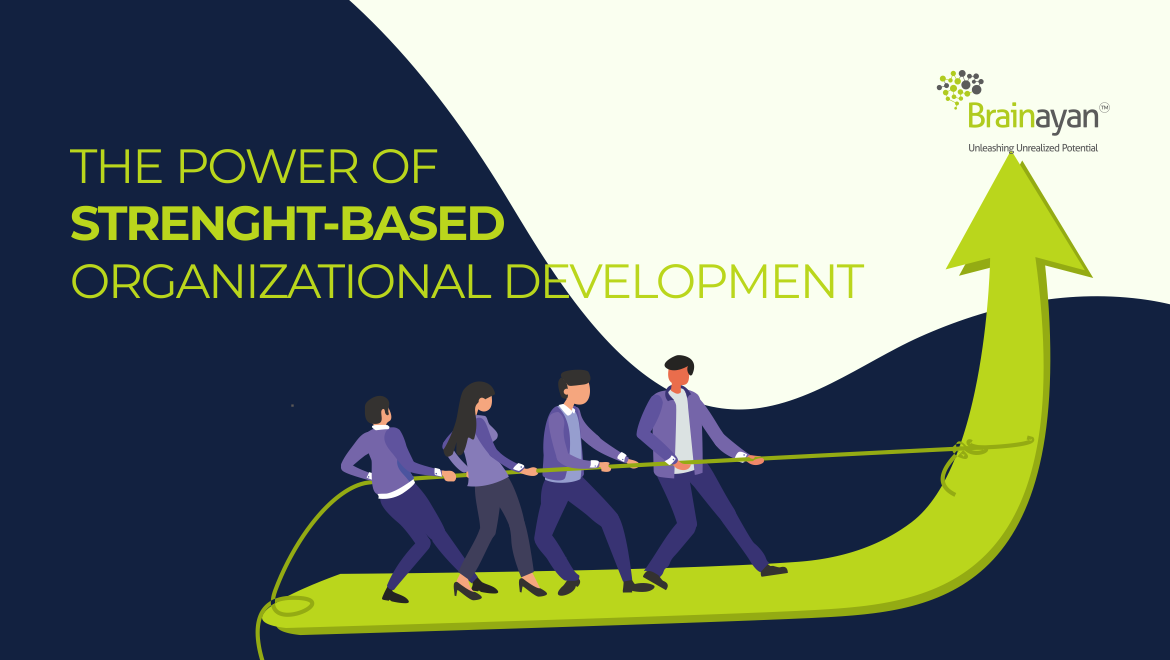The Power of Strength-Based Organizational Development

In today’s fast-paced and ever-changing business landscape, organizations face numerous challenges. To thrive and succeed, they must adapt, evolve, and continuously improve. One approach that has gained considerable attention is Strength-Based Organizational Development (SOD). This powerful methodology focuses on identifying and nurturing the strengths of individuals and teams within an organization. A strengths-based framework is used to nurture skills and knowledge and ensure that employees spend most of the time developing and applying their strengths.
At its core, Strength-Based Organizational Development is about shifting the focus from fixing weaknesses to enhancing strengths. Rather than dwelling on what’s wrong or deficient, SOD encourages organizations to identify and leverage their existing capabilities and talents. Basically, organisations now tap in to the resources they have and make the best of them.
Cooperrider (2002) describes the deficit-based emphasis as one where the focus is on what is wrong and ‘fixing it’ through intervention strategies. Problems are identified and efforts are made to ‘fill the gap’ between where we are and where we want to get to. However, with a strengths-focused approach the focus is on collaboratively identifying what is right and enhancing it. The aim is to identify and amplify the core strengths that people have. It requires a shift in learning systems, processes, practice and mindset (Staron, 2021).
Strength based approach also solves for 2 major organisational factors. First being performance and second engagement. Engaged employees are more likely to go the extra mile, driving innovation and contributing to the overall success of the organization. Research and evidence, both show that employees and teams that experience the strengths based approach are 74% more engaged than those who don’t.
When employees get to display their strengths, they tend to perform well on the tasks as they come naturally to the employees. When their strengths are used for tasks, they feel even more motivated to perform. Additionally, because the task is related to their strength and they are able to perform, engagement at work is also solved for.
In the traditional problem-focused model, employees are often subjected to lengthy performance appraisals, boring one on one’s and extensive development plans that focus on improving areas of weakness. This approach demoralizes individuals and hinder their growth. A strengths based organisational culture also promotes coaching feedback and prioritises the well-being and development of the employees. Gallup data shows that employees leave organisations because they cannot grow and develop.
The question that arises is ‘doesn’t addressing weaknesses equates to personal growth?’. In such cases, it is beneficial to consider the significance of a weakness in relation to your current or desired role. If a specific weakness acts as a barrier to achieving your growth plans, then investing time and energy into resolving it becomes worthwhile. However, if a weakness does not significantly impede your progress, it is more advantageous to channel your efforts towards areas that align with your long-term vision.
A strength-based approach also does not replace your existing organisational culture; it helps you amplify the best parts of it. In fact, in a meta-analysis conducted by Gallup, it was found that 19% increased sales, 29% increased profits, and 72% lower turnover in high turnover organisations.
Organisational culture and strengths-based leadership are more about what leaders do and the choices they make than they are about what CEOs say. Leadership participation fuses organisational culture’s importance with strengths. Additionally, alignment provides teams and managers with a clear path, enabling them to focus their time, energy, and resources on strengths-based development. Here’s what you can do for developing a strengths-based approach:
- Align tasks and projects with strengths
- Communicate how applying strengths will enable the company to achieve its purpose and business objectives.
- Work with employees individually to uncover their strengths and interests.
- Articulate how the strengths initiative is connected to the organisation’s identity.
- Think about the people you are talking to and consider how their talent DNA is at work. Recognize it when you see it in action.
- Communicate your strengths and how you implement them at work.
- Building on strengths shouldn’t come at the expense of learning something employees have a desire to learn.
- Review current performance management systems and processes, and identify areas of opportunity for integrating strengths.
- Infuse strengths when setting daily, weekly, monthly, quarterly goals, and clarifying expectations.
In conclusion, strength-based organisational development provides a novel and successful strategy for achieving organisational success. Organisations may maximise their potential for development and success in a changing business environment by recognising and utilising the distinctive skills of individuals and teams.
References:
Staron, M. (2011). Life-based learning model–a model for strength-based approaches to capability development and implications for personal development planning. Mindful Creations, February, 1-14.
https://www.gallup.com/cliftonstrengths/en/290903/how-to-create-strengths-based-company-culture.aspx
https://www.jesswass.com/blog/should-you-embrace-your-strengths-or-fix-your-weaknesses
https://hrdailyadvisor.blr.com/2020/03/04/what-is-strengths-based-management/

With a master’s in clinical psychology, Aasawari specializes in behaviour and mindset change, leveraging her understanding human behaviour to bring about personal and professional transformations. As a passionate researcher, she delves into the latest studies and findings to create insightful and evidence-based blog articles. She strives to bridge the gap between theory and practice by simplifying complex research to provide practically actionable recommendations.